The Importance of Soft Skills
VerifiedAdded on 2020/05/16
|16
|5085
|34
AI Summary
This assignment delves into the crucial role of soft skills in contemporary professional settings. It emphasizes the influence of soft skills on various aspects of workplace success, including effective communication, collaboration within teams, and demonstrating strong leadership qualities. The provided articles shed light on the development and importance of these skills.
Contribute Materials
Your contribution can guide someone’s learning journey. Share your
documents today.

Running head: EFFECTIVE BUISNESS COMMUNICATION
EFFECTIVE BUISNESS COMMUNICATION
Name of the student:
Name of the university:
Author note:
EFFECTIVE BUISNESS COMMUNICATION
Name of the student:
Name of the university:
Author note:
Secure Best Marks with AI Grader
Need help grading? Try our AI Grader for instant feedback on your assignments.
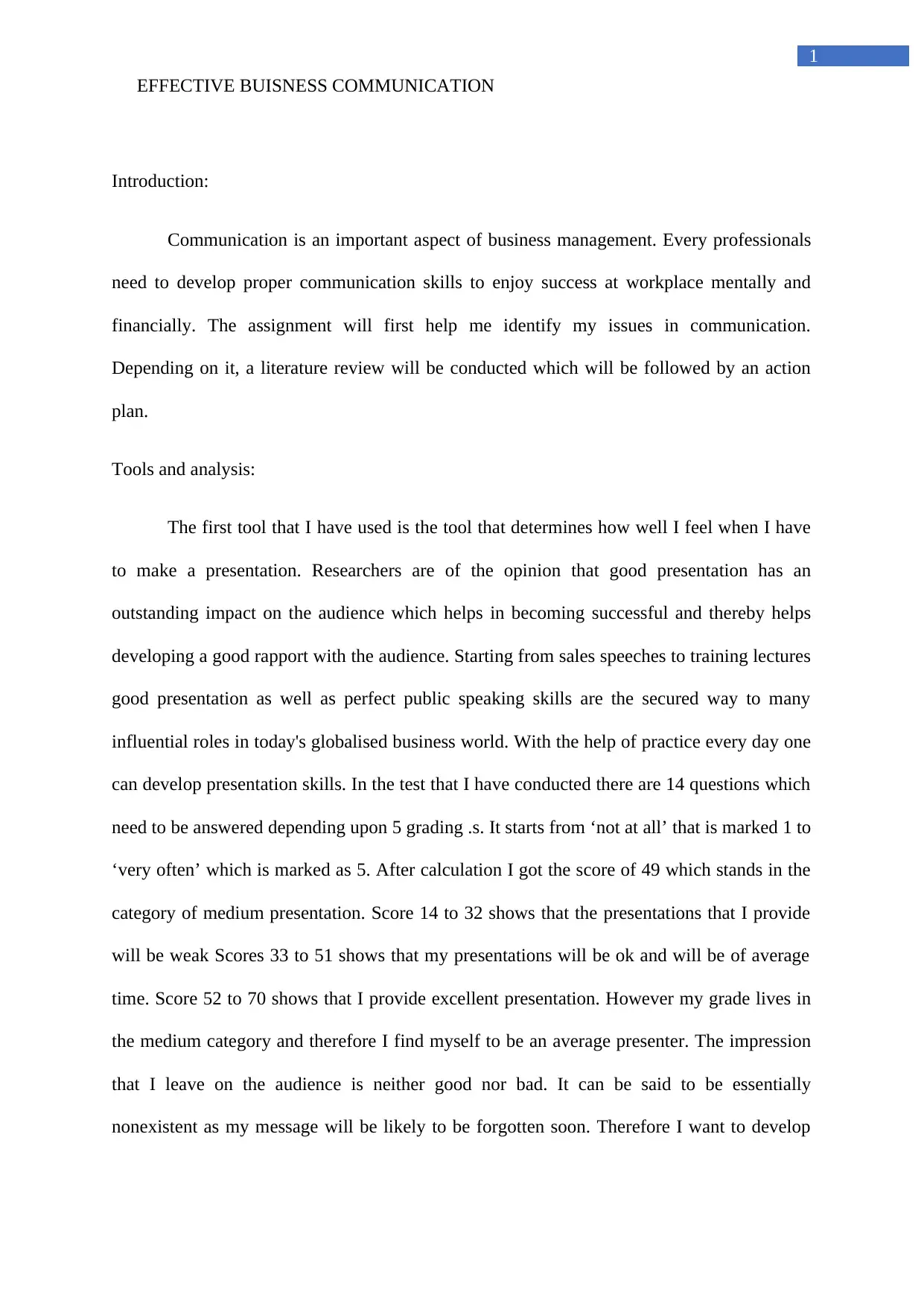
1
EFFECTIVE BUISNESS COMMUNICATION
Introduction:
Communication is an important aspect of business management. Every professionals
need to develop proper communication skills to enjoy success at workplace mentally and
financially. The assignment will first help me identify my issues in communication.
Depending on it, a literature review will be conducted which will be followed by an action
plan.
Tools and analysis:
The first tool that I have used is the tool that determines how well I feel when I have
to make a presentation. Researchers are of the opinion that good presentation has an
outstanding impact on the audience which helps in becoming successful and thereby helps
developing a good rapport with the audience. Starting from sales speeches to training lectures
good presentation as well as perfect public speaking skills are the secured way to many
influential roles in today's globalised business world. With the help of practice every day one
can develop presentation skills. In the test that I have conducted there are 14 questions which
need to be answered depending upon 5 grading .s. It starts from ‘not at all’ that is marked 1 to
‘very often’ which is marked as 5. After calculation I got the score of 49 which stands in the
category of medium presentation. Score 14 to 32 shows that the presentations that I provide
will be weak Scores 33 to 51 shows that my presentations will be ok and will be of average
time. Score 52 to 70 shows that I provide excellent presentation. However my grade lives in
the medium category and therefore I find myself to be an average presenter. The impression
that I leave on the audience is neither good nor bad. It can be said to be essentially
nonexistent as my message will be likely to be forgotten soon. Therefore I want to develop
EFFECTIVE BUISNESS COMMUNICATION
Introduction:
Communication is an important aspect of business management. Every professionals
need to develop proper communication skills to enjoy success at workplace mentally and
financially. The assignment will first help me identify my issues in communication.
Depending on it, a literature review will be conducted which will be followed by an action
plan.
Tools and analysis:
The first tool that I have used is the tool that determines how well I feel when I have
to make a presentation. Researchers are of the opinion that good presentation has an
outstanding impact on the audience which helps in becoming successful and thereby helps
developing a good rapport with the audience. Starting from sales speeches to training lectures
good presentation as well as perfect public speaking skills are the secured way to many
influential roles in today's globalised business world. With the help of practice every day one
can develop presentation skills. In the test that I have conducted there are 14 questions which
need to be answered depending upon 5 grading .s. It starts from ‘not at all’ that is marked 1 to
‘very often’ which is marked as 5. After calculation I got the score of 49 which stands in the
category of medium presentation. Score 14 to 32 shows that the presentations that I provide
will be weak Scores 33 to 51 shows that my presentations will be ok and will be of average
time. Score 52 to 70 shows that I provide excellent presentation. However my grade lives in
the medium category and therefore I find myself to be an average presenter. The impression
that I leave on the audience is neither good nor bad. It can be said to be essentially
nonexistent as my message will be likely to be forgotten soon. Therefore I want to develop
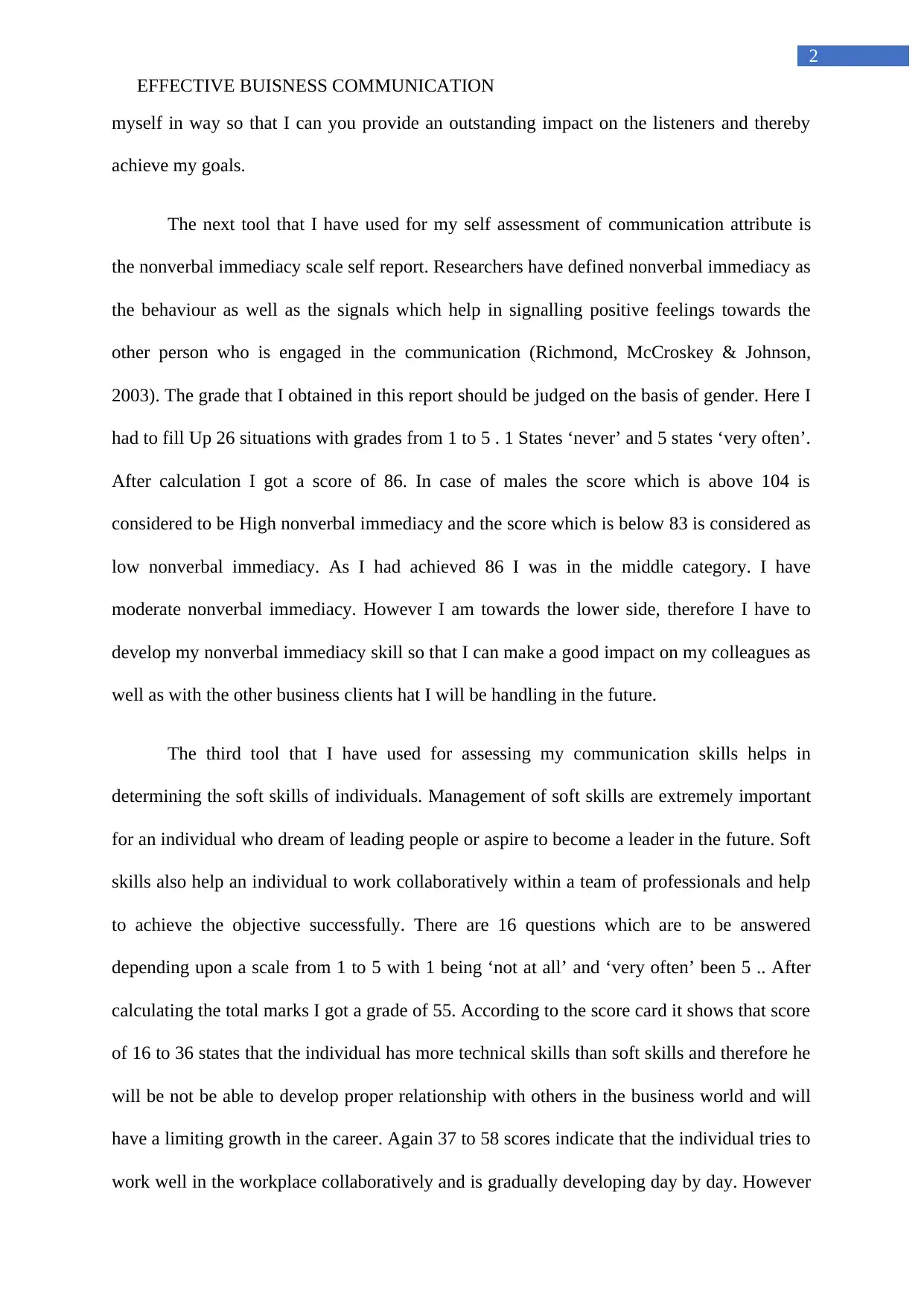
2
EFFECTIVE BUISNESS COMMUNICATION
myself in way so that I can you provide an outstanding impact on the listeners and thereby
achieve my goals.
The next tool that I have used for my self assessment of communication attribute is
the nonverbal immediacy scale self report. Researchers have defined nonverbal immediacy as
the behaviour as well as the signals which help in signalling positive feelings towards the
other person who is engaged in the communication (Richmond, McCroskey & Johnson,
2003). The grade that I obtained in this report should be judged on the basis of gender. Here I
had to fill Up 26 situations with grades from 1 to 5 . 1 States ‘never’ and 5 states ‘very often’.
After calculation I got a score of 86. In case of males the score which is above 104 is
considered to be High nonverbal immediacy and the score which is below 83 is considered as
low nonverbal immediacy. As I had achieved 86 I was in the middle category. I have
moderate nonverbal immediacy. However I am towards the lower side, therefore I have to
develop my nonverbal immediacy skill so that I can make a good impact on my colleagues as
well as with the other business clients hat I will be handling in the future.
The third tool that I have used for assessing my communication skills helps in
determining the soft skills of individuals. Management of soft skills are extremely important
for an individual who dream of leading people or aspire to become a leader in the future. Soft
skills also help an individual to work collaboratively within a team of professionals and help
to achieve the objective successfully. There are 16 questions which are to be answered
depending upon a scale from 1 to 5 with 1 being ‘not at all’ and ‘very often’ been 5 .. After
calculating the total marks I got a grade of 55. According to the score card it shows that score
of 16 to 36 states that the individual has more technical skills than soft skills and therefore he
will be not be able to develop proper relationship with others in the business world and will
have a limiting growth in the career. Again 37 to 58 scores indicate that the individual tries to
work well in the workplace collaboratively and is gradually developing day by day. However
EFFECTIVE BUISNESS COMMUNICATION
myself in way so that I can you provide an outstanding impact on the listeners and thereby
achieve my goals.
The next tool that I have used for my self assessment of communication attribute is
the nonverbal immediacy scale self report. Researchers have defined nonverbal immediacy as
the behaviour as well as the signals which help in signalling positive feelings towards the
other person who is engaged in the communication (Richmond, McCroskey & Johnson,
2003). The grade that I obtained in this report should be judged on the basis of gender. Here I
had to fill Up 26 situations with grades from 1 to 5 . 1 States ‘never’ and 5 states ‘very often’.
After calculation I got a score of 86. In case of males the score which is above 104 is
considered to be High nonverbal immediacy and the score which is below 83 is considered as
low nonverbal immediacy. As I had achieved 86 I was in the middle category. I have
moderate nonverbal immediacy. However I am towards the lower side, therefore I have to
develop my nonverbal immediacy skill so that I can make a good impact on my colleagues as
well as with the other business clients hat I will be handling in the future.
The third tool that I have used for assessing my communication skills helps in
determining the soft skills of individuals. Management of soft skills are extremely important
for an individual who dream of leading people or aspire to become a leader in the future. Soft
skills also help an individual to work collaboratively within a team of professionals and help
to achieve the objective successfully. There are 16 questions which are to be answered
depending upon a scale from 1 to 5 with 1 being ‘not at all’ and ‘very often’ been 5 .. After
calculating the total marks I got a grade of 55. According to the score card it shows that score
of 16 to 36 states that the individual has more technical skills than soft skills and therefore he
will be not be able to develop proper relationship with others in the business world and will
have a limiting growth in the career. Again 37 to 58 scores indicate that the individual tries to
work well in the workplace collaboratively and is gradually developing day by day. However
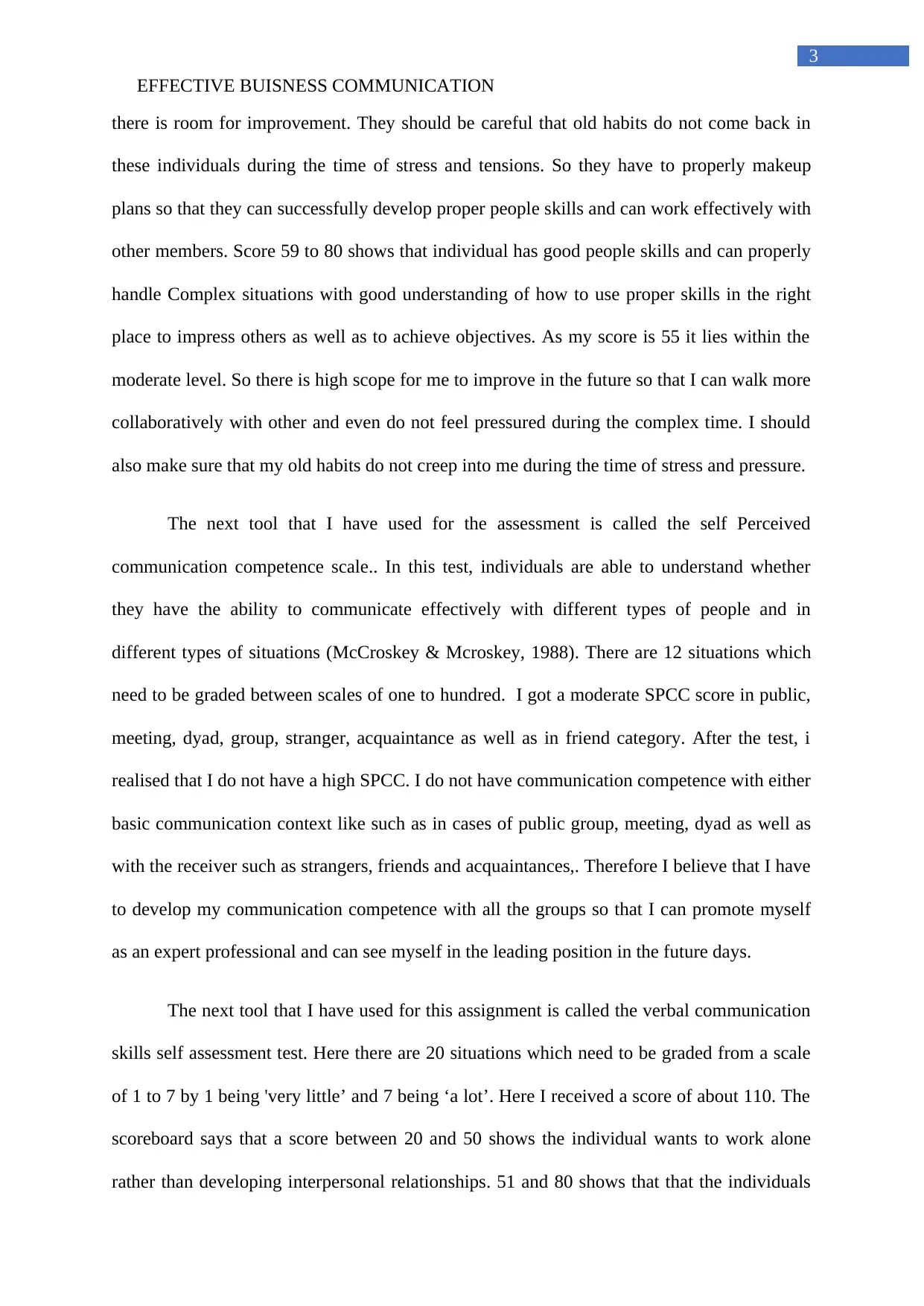
3
EFFECTIVE BUISNESS COMMUNICATION
there is room for improvement. They should be careful that old habits do not come back in
these individuals during the time of stress and tensions. So they have to properly makeup
plans so that they can successfully develop proper people skills and can work effectively with
other members. Score 59 to 80 shows that individual has good people skills and can properly
handle Complex situations with good understanding of how to use proper skills in the right
place to impress others as well as to achieve objectives. As my score is 55 it lies within the
moderate level. So there is high scope for me to improve in the future so that I can walk more
collaboratively with other and even do not feel pressured during the complex time. I should
also make sure that my old habits do not creep into me during the time of stress and pressure.
The next tool that I have used for the assessment is called the self Perceived
communication competence scale.. In this test, individuals are able to understand whether
they have the ability to communicate effectively with different types of people and in
different types of situations (McCroskey & Mcroskey, 1988). There are 12 situations which
need to be graded between scales of one to hundred. I got a moderate SPCC score in public,
meeting, dyad, group, stranger, acquaintance as well as in friend category. After the test, i
realised that I do not have a high SPCC. I do not have communication competence with either
basic communication context like such as in cases of public group, meeting, dyad as well as
with the receiver such as strangers, friends and acquaintances,. Therefore I believe that I have
to develop my communication competence with all the groups so that I can promote myself
as an expert professional and can see myself in the leading position in the future days.
The next tool that I have used for this assignment is called the verbal communication
skills self assessment test. Here there are 20 situations which need to be graded from a scale
of 1 to 7 by 1 being 'very little’ and 7 being ‘a lot’. Here I received a score of about 110. The
scoreboard says that a score between 20 and 50 shows the individual wants to work alone
rather than developing interpersonal relationships. 51 and 80 shows that that the individuals
EFFECTIVE BUISNESS COMMUNICATION
there is room for improvement. They should be careful that old habits do not come back in
these individuals during the time of stress and tensions. So they have to properly makeup
plans so that they can successfully develop proper people skills and can work effectively with
other members. Score 59 to 80 shows that individual has good people skills and can properly
handle Complex situations with good understanding of how to use proper skills in the right
place to impress others as well as to achieve objectives. As my score is 55 it lies within the
moderate level. So there is high scope for me to improve in the future so that I can walk more
collaboratively with other and even do not feel pressured during the complex time. I should
also make sure that my old habits do not creep into me during the time of stress and pressure.
The next tool that I have used for the assessment is called the self Perceived
communication competence scale.. In this test, individuals are able to understand whether
they have the ability to communicate effectively with different types of people and in
different types of situations (McCroskey & Mcroskey, 1988). There are 12 situations which
need to be graded between scales of one to hundred. I got a moderate SPCC score in public,
meeting, dyad, group, stranger, acquaintance as well as in friend category. After the test, i
realised that I do not have a high SPCC. I do not have communication competence with either
basic communication context like such as in cases of public group, meeting, dyad as well as
with the receiver such as strangers, friends and acquaintances,. Therefore I believe that I have
to develop my communication competence with all the groups so that I can promote myself
as an expert professional and can see myself in the leading position in the future days.
The next tool that I have used for this assignment is called the verbal communication
skills self assessment test. Here there are 20 situations which need to be graded from a scale
of 1 to 7 by 1 being 'very little’ and 7 being ‘a lot’. Here I received a score of about 110. The
scoreboard says that a score between 20 and 50 shows the individual wants to work alone
rather than developing interpersonal relationships. 51 and 80 shows that that the individuals
Secure Best Marks with AI Grader
Need help grading? Try our AI Grader for instant feedback on your assignments.
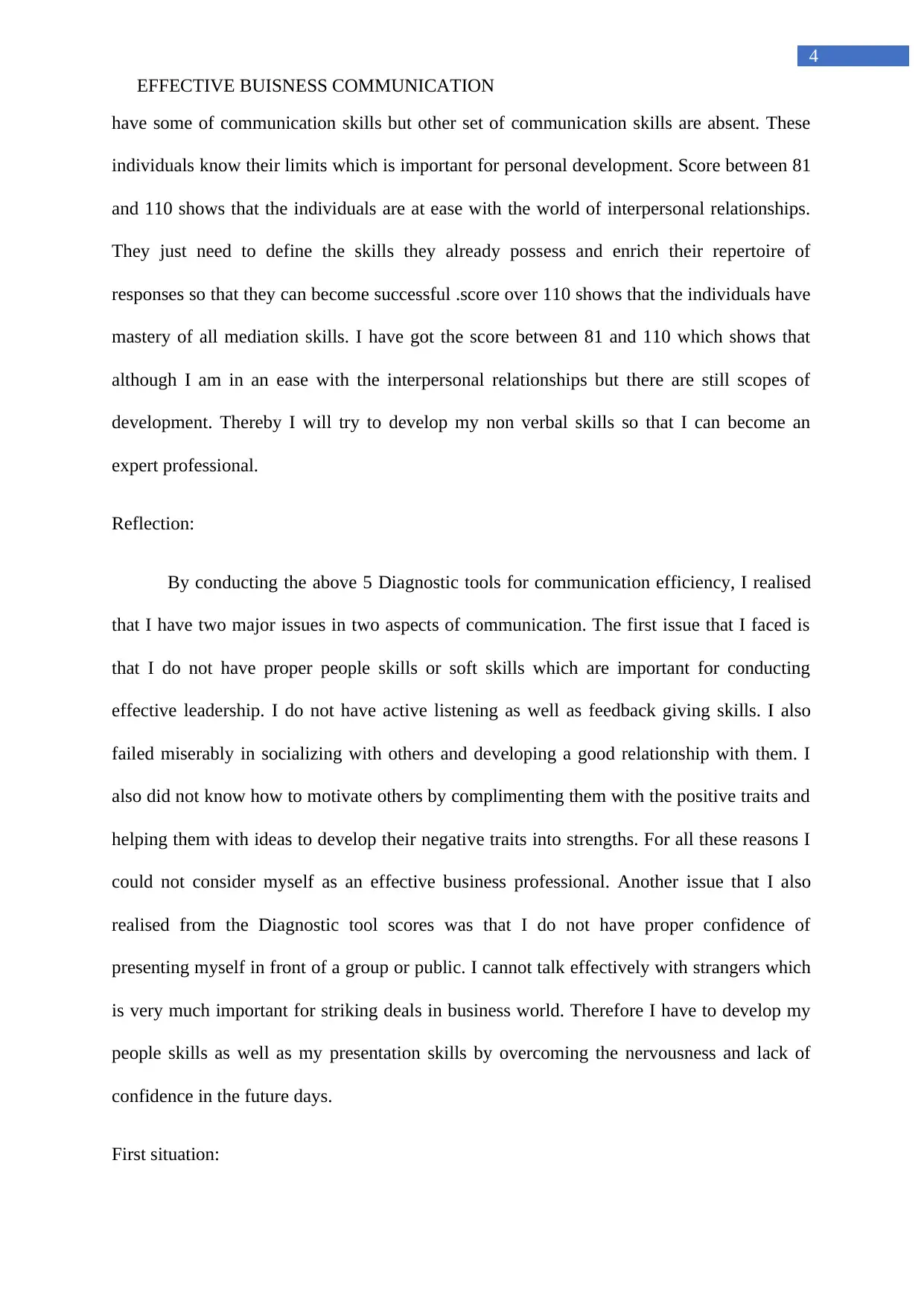
4
EFFECTIVE BUISNESS COMMUNICATION
have some of communication skills but other set of communication skills are absent. These
individuals know their limits which is important for personal development. Score between 81
and 110 shows that the individuals are at ease with the world of interpersonal relationships.
They just need to define the skills they already possess and enrich their repertoire of
responses so that they can become successful .score over 110 shows that the individuals have
mastery of all mediation skills. I have got the score between 81 and 110 which shows that
although I am in an ease with the interpersonal relationships but there are still scopes of
development. Thereby I will try to develop my non verbal skills so that I can become an
expert professional.
Reflection:
By conducting the above 5 Diagnostic tools for communication efficiency, I realised
that I have two major issues in two aspects of communication. The first issue that I faced is
that I do not have proper people skills or soft skills which are important for conducting
effective leadership. I do not have active listening as well as feedback giving skills. I also
failed miserably in socializing with others and developing a good relationship with them. I
also did not know how to motivate others by complimenting them with the positive traits and
helping them with ideas to develop their negative traits into strengths. For all these reasons I
could not consider myself as an effective business professional. Another issue that I also
realised from the Diagnostic tool scores was that I do not have proper confidence of
presenting myself in front of a group or public. I cannot talk effectively with strangers which
is very much important for striking deals in business world. Therefore I have to develop my
people skills as well as my presentation skills by overcoming the nervousness and lack of
confidence in the future days.
First situation:
EFFECTIVE BUISNESS COMMUNICATION
have some of communication skills but other set of communication skills are absent. These
individuals know their limits which is important for personal development. Score between 81
and 110 shows that the individuals are at ease with the world of interpersonal relationships.
They just need to define the skills they already possess and enrich their repertoire of
responses so that they can become successful .score over 110 shows that the individuals have
mastery of all mediation skills. I have got the score between 81 and 110 which shows that
although I am in an ease with the interpersonal relationships but there are still scopes of
development. Thereby I will try to develop my non verbal skills so that I can become an
expert professional.
Reflection:
By conducting the above 5 Diagnostic tools for communication efficiency, I realised
that I have two major issues in two aspects of communication. The first issue that I faced is
that I do not have proper people skills or soft skills which are important for conducting
effective leadership. I do not have active listening as well as feedback giving skills. I also
failed miserably in socializing with others and developing a good relationship with them. I
also did not know how to motivate others by complimenting them with the positive traits and
helping them with ideas to develop their negative traits into strengths. For all these reasons I
could not consider myself as an effective business professional. Another issue that I also
realised from the Diagnostic tool scores was that I do not have proper confidence of
presenting myself in front of a group or public. I cannot talk effectively with strangers which
is very much important for striking deals in business world. Therefore I have to develop my
people skills as well as my presentation skills by overcoming the nervousness and lack of
confidence in the future days.
First situation:
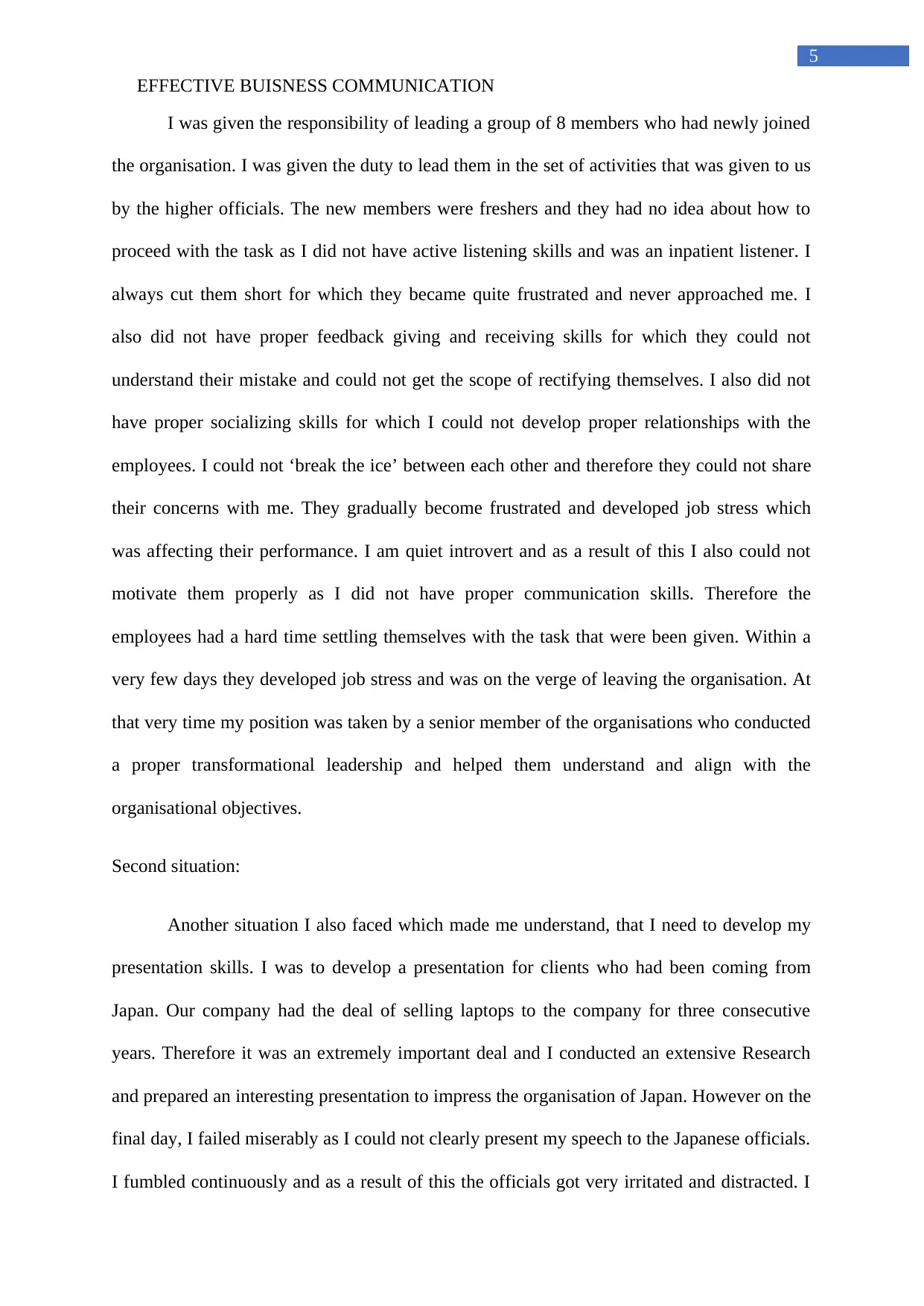
5
EFFECTIVE BUISNESS COMMUNICATION
I was given the responsibility of leading a group of 8 members who had newly joined
the organisation. I was given the duty to lead them in the set of activities that was given to us
by the higher officials. The new members were freshers and they had no idea about how to
proceed with the task as I did not have active listening skills and was an inpatient listener. I
always cut them short for which they became quite frustrated and never approached me. I
also did not have proper feedback giving and receiving skills for which they could not
understand their mistake and could not get the scope of rectifying themselves. I also did not
have proper socializing skills for which I could not develop proper relationships with the
employees. I could not ‘break the ice’ between each other and therefore they could not share
their concerns with me. They gradually become frustrated and developed job stress which
was affecting their performance. I am quiet introvert and as a result of this I also could not
motivate them properly as I did not have proper communication skills. Therefore the
employees had a hard time settling themselves with the task that were been given. Within a
very few days they developed job stress and was on the verge of leaving the organisation. At
that very time my position was taken by a senior member of the organisations who conducted
a proper transformational leadership and helped them understand and align with the
organisational objectives.
Second situation:
Another situation I also faced which made me understand, that I need to develop my
presentation skills. I was to develop a presentation for clients who had been coming from
Japan. Our company had the deal of selling laptops to the company for three consecutive
years. Therefore it was an extremely important deal and I conducted an extensive Research
and prepared an interesting presentation to impress the organisation of Japan. However on the
final day, I failed miserably as I could not clearly present my speech to the Japanese officials.
I fumbled continuously and as a result of this the officials got very irritated and distracted. I
EFFECTIVE BUISNESS COMMUNICATION
I was given the responsibility of leading a group of 8 members who had newly joined
the organisation. I was given the duty to lead them in the set of activities that was given to us
by the higher officials. The new members were freshers and they had no idea about how to
proceed with the task as I did not have active listening skills and was an inpatient listener. I
always cut them short for which they became quite frustrated and never approached me. I
also did not have proper feedback giving and receiving skills for which they could not
understand their mistake and could not get the scope of rectifying themselves. I also did not
have proper socializing skills for which I could not develop proper relationships with the
employees. I could not ‘break the ice’ between each other and therefore they could not share
their concerns with me. They gradually become frustrated and developed job stress which
was affecting their performance. I am quiet introvert and as a result of this I also could not
motivate them properly as I did not have proper communication skills. Therefore the
employees had a hard time settling themselves with the task that were been given. Within a
very few days they developed job stress and was on the verge of leaving the organisation. At
that very time my position was taken by a senior member of the organisations who conducted
a proper transformational leadership and helped them understand and align with the
organisational objectives.
Second situation:
Another situation I also faced which made me understand, that I need to develop my
presentation skills. I was to develop a presentation for clients who had been coming from
Japan. Our company had the deal of selling laptops to the company for three consecutive
years. Therefore it was an extremely important deal and I conducted an extensive Research
and prepared an interesting presentation to impress the organisation of Japan. However on the
final day, I failed miserably as I could not clearly present my speech to the Japanese officials.
I fumbled continuously and as a result of this the officials got very irritated and distracted. I
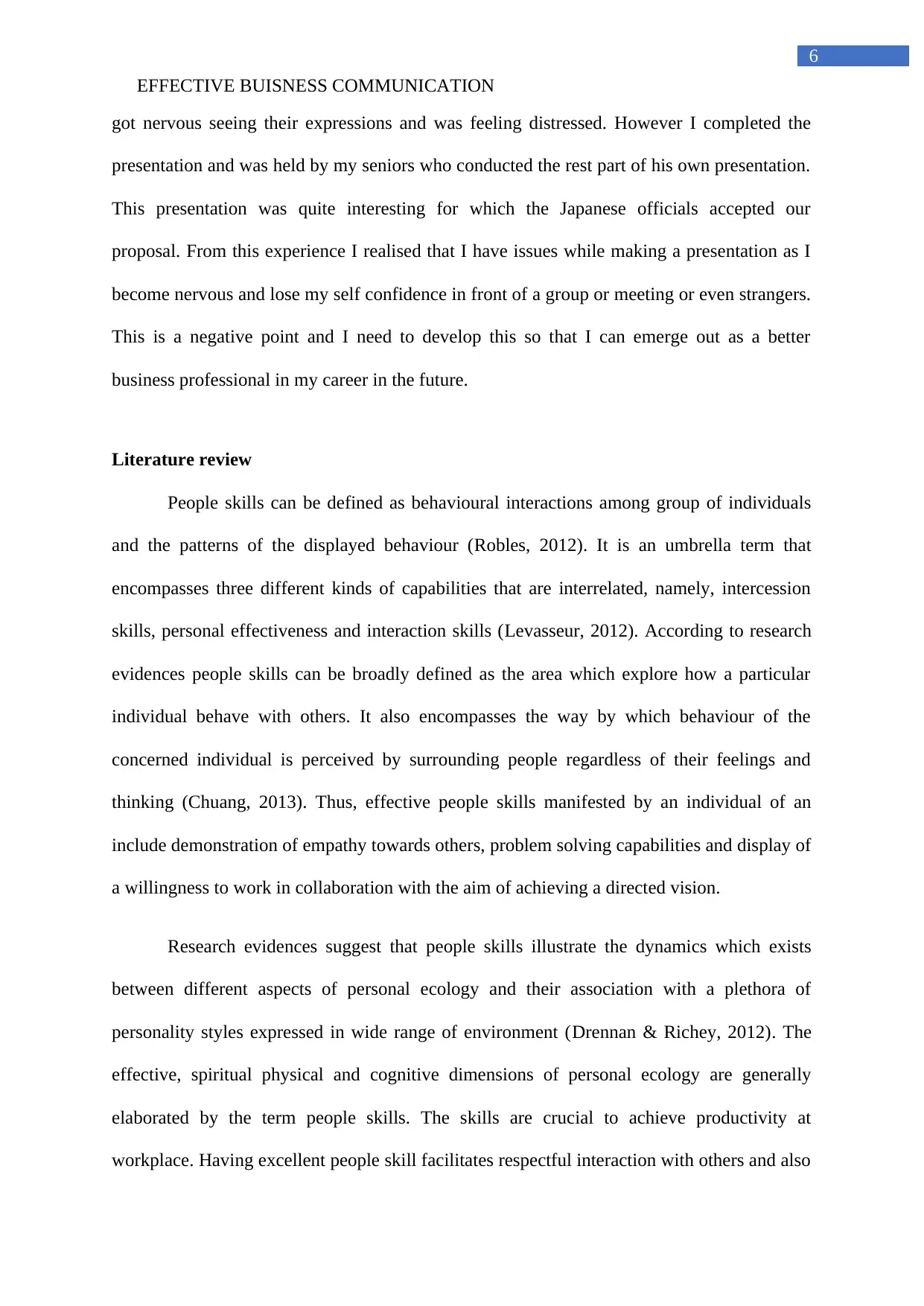
6
EFFECTIVE BUISNESS COMMUNICATION
got nervous seeing their expressions and was feeling distressed. However I completed the
presentation and was held by my seniors who conducted the rest part of his own presentation.
This presentation was quite interesting for which the Japanese officials accepted our
proposal. From this experience I realised that I have issues while making a presentation as I
become nervous and lose my self confidence in front of a group or meeting or even strangers.
This is a negative point and I need to develop this so that I can emerge out as a better
business professional in my career in the future.
Literature review
People skills can be defined as behavioural interactions among group of individuals
and the patterns of the displayed behaviour (Robles, 2012). It is an umbrella term that
encompasses three different kinds of capabilities that are interrelated, namely, intercession
skills, personal effectiveness and interaction skills (Levasseur, 2012). According to research
evidences people skills can be broadly defined as the area which explore how a particular
individual behave with others. It also encompasses the way by which behaviour of the
concerned individual is perceived by surrounding people regardless of their feelings and
thinking (Chuang, 2013). Thus, effective people skills manifested by an individual of an
include demonstration of empathy towards others, problem solving capabilities and display of
a willingness to work in collaboration with the aim of achieving a directed vision.
Research evidences suggest that people skills illustrate the dynamics which exists
between different aspects of personal ecology and their association with a plethora of
personality styles expressed in wide range of environment (Drennan & Richey, 2012). The
effective, spiritual physical and cognitive dimensions of personal ecology are generally
elaborated by the term people skills. The skills are crucial to achieve productivity at
workplace. Having excellent people skill facilitates respectful interaction with others and also
EFFECTIVE BUISNESS COMMUNICATION
got nervous seeing their expressions and was feeling distressed. However I completed the
presentation and was held by my seniors who conducted the rest part of his own presentation.
This presentation was quite interesting for which the Japanese officials accepted our
proposal. From this experience I realised that I have issues while making a presentation as I
become nervous and lose my self confidence in front of a group or meeting or even strangers.
This is a negative point and I need to develop this so that I can emerge out as a better
business professional in my career in the future.
Literature review
People skills can be defined as behavioural interactions among group of individuals
and the patterns of the displayed behaviour (Robles, 2012). It is an umbrella term that
encompasses three different kinds of capabilities that are interrelated, namely, intercession
skills, personal effectiveness and interaction skills (Levasseur, 2012). According to research
evidences people skills can be broadly defined as the area which explore how a particular
individual behave with others. It also encompasses the way by which behaviour of the
concerned individual is perceived by surrounding people regardless of their feelings and
thinking (Chuang, 2013). Thus, effective people skills manifested by an individual of an
include demonstration of empathy towards others, problem solving capabilities and display of
a willingness to work in collaboration with the aim of achieving a directed vision.
Research evidences suggest that people skills illustrate the dynamics which exists
between different aspects of personal ecology and their association with a plethora of
personality styles expressed in wide range of environment (Drennan & Richey, 2012). The
effective, spiritual physical and cognitive dimensions of personal ecology are generally
elaborated by the term people skills. The skills are crucial to achieve productivity at
workplace. Having excellent people skill facilitates respectful interaction with others and also
Paraphrase This Document
Need a fresh take? Get an instant paraphrase of this document with our AI Paraphraser
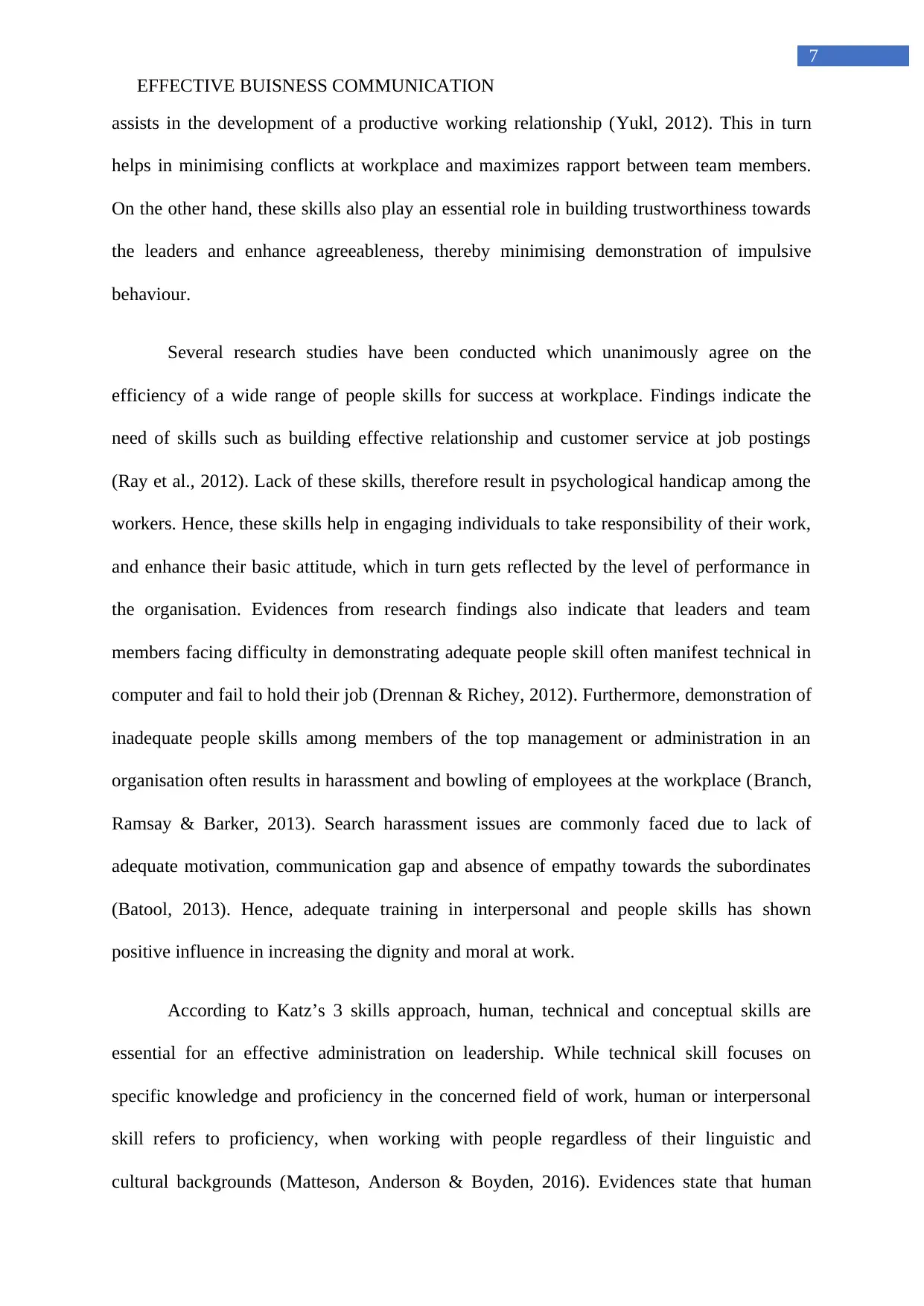
7
EFFECTIVE BUISNESS COMMUNICATION
assists in the development of a productive working relationship (Yukl, 2012). This in turn
helps in minimising conflicts at workplace and maximizes rapport between team members.
On the other hand, these skills also play an essential role in building trustworthiness towards
the leaders and enhance agreeableness, thereby minimising demonstration of impulsive
behaviour.
Several research studies have been conducted which unanimously agree on the
efficiency of a wide range of people skills for success at workplace. Findings indicate the
need of skills such as building effective relationship and customer service at job postings
(Ray et al., 2012). Lack of these skills, therefore result in psychological handicap among the
workers. Hence, these skills help in engaging individuals to take responsibility of their work,
and enhance their basic attitude, which in turn gets reflected by the level of performance in
the organisation. Evidences from research findings also indicate that leaders and team
members facing difficulty in demonstrating adequate people skill often manifest technical in
computer and fail to hold their job (Drennan & Richey, 2012). Furthermore, demonstration of
inadequate people skills among members of the top management or administration in an
organisation often results in harassment and bowling of employees at the workplace (Branch,
Ramsay & Barker, 2013). Search harassment issues are commonly faced due to lack of
adequate motivation, communication gap and absence of empathy towards the subordinates
(Batool, 2013). Hence, adequate training in interpersonal and people skills has shown
positive influence in increasing the dignity and moral at work.
According to Katz’s 3 skills approach, human, technical and conceptual skills are
essential for an effective administration on leadership. While technical skill focuses on
specific knowledge and proficiency in the concerned field of work, human or interpersonal
skill refers to proficiency, when working with people regardless of their linguistic and
cultural backgrounds (Matteson, Anderson & Boyden, 2016). Evidences state that human
EFFECTIVE BUISNESS COMMUNICATION
assists in the development of a productive working relationship (Yukl, 2012). This in turn
helps in minimising conflicts at workplace and maximizes rapport between team members.
On the other hand, these skills also play an essential role in building trustworthiness towards
the leaders and enhance agreeableness, thereby minimising demonstration of impulsive
behaviour.
Several research studies have been conducted which unanimously agree on the
efficiency of a wide range of people skills for success at workplace. Findings indicate the
need of skills such as building effective relationship and customer service at job postings
(Ray et al., 2012). Lack of these skills, therefore result in psychological handicap among the
workers. Hence, these skills help in engaging individuals to take responsibility of their work,
and enhance their basic attitude, which in turn gets reflected by the level of performance in
the organisation. Evidences from research findings also indicate that leaders and team
members facing difficulty in demonstrating adequate people skill often manifest technical in
computer and fail to hold their job (Drennan & Richey, 2012). Furthermore, demonstration of
inadequate people skills among members of the top management or administration in an
organisation often results in harassment and bowling of employees at the workplace (Branch,
Ramsay & Barker, 2013). Search harassment issues are commonly faced due to lack of
adequate motivation, communication gap and absence of empathy towards the subordinates
(Batool, 2013). Hence, adequate training in interpersonal and people skills has shown
positive influence in increasing the dignity and moral at work.
According to Katz’s 3 skills approach, human, technical and conceptual skills are
essential for an effective administration on leadership. While technical skill focuses on
specific knowledge and proficiency in the concerned field of work, human or interpersonal
skill refers to proficiency, when working with people regardless of their linguistic and
cultural backgrounds (Matteson, Anderson & Boyden, 2016). Evidences state that human
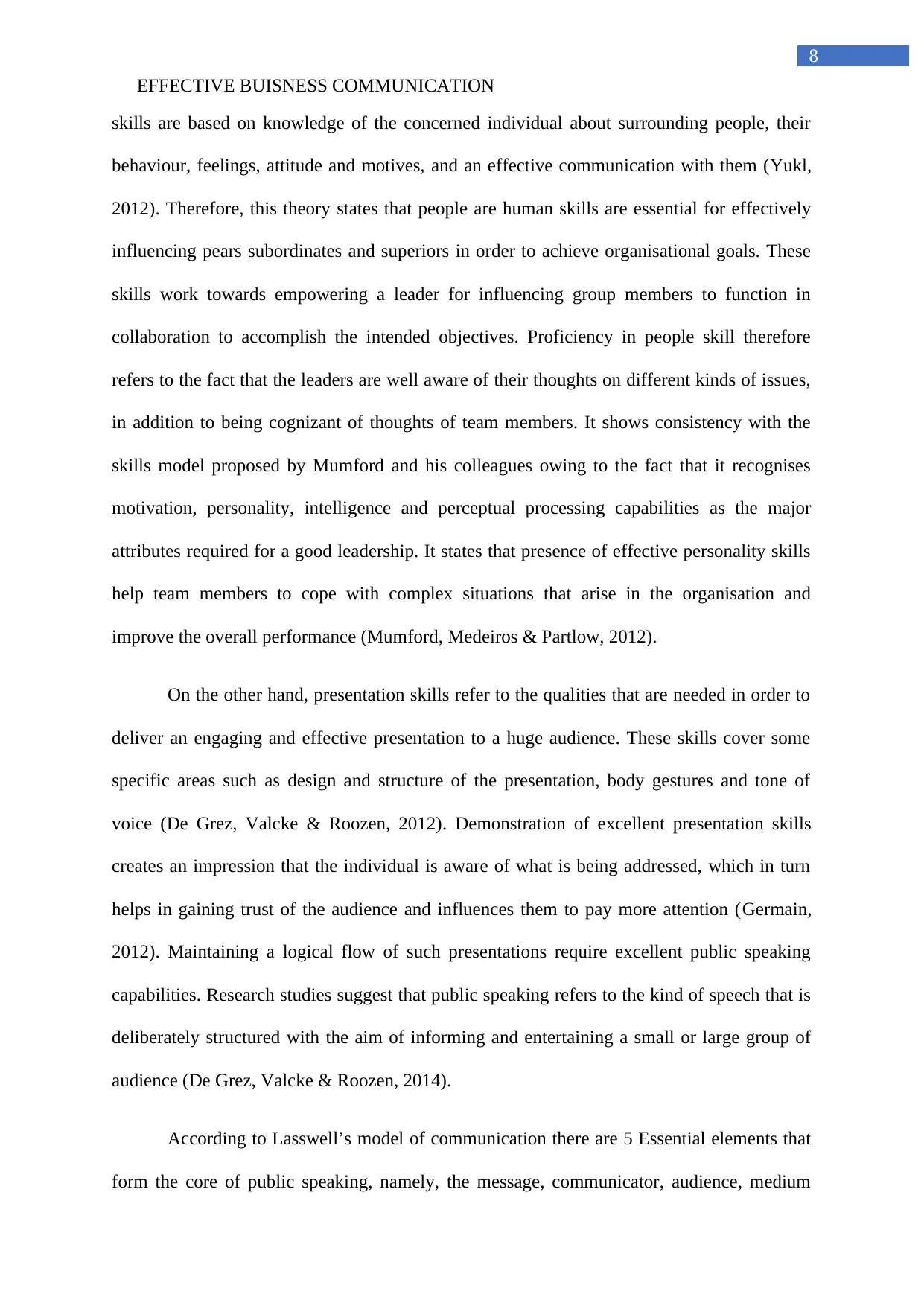
8
EFFECTIVE BUISNESS COMMUNICATION
skills are based on knowledge of the concerned individual about surrounding people, their
behaviour, feelings, attitude and motives, and an effective communication with them (Yukl,
2012). Therefore, this theory states that people are human skills are essential for effectively
influencing pears subordinates and superiors in order to achieve organisational goals. These
skills work towards empowering a leader for influencing group members to function in
collaboration to accomplish the intended objectives. Proficiency in people skill therefore
refers to the fact that the leaders are well aware of their thoughts on different kinds of issues,
in addition to being cognizant of thoughts of team members. It shows consistency with the
skills model proposed by Mumford and his colleagues owing to the fact that it recognises
motivation, personality, intelligence and perceptual processing capabilities as the major
attributes required for a good leadership. It states that presence of effective personality skills
help team members to cope with complex situations that arise in the organisation and
improve the overall performance (Mumford, Medeiros & Partlow, 2012).
On the other hand, presentation skills refer to the qualities that are needed in order to
deliver an engaging and effective presentation to a huge audience. These skills cover some
specific areas such as design and structure of the presentation, body gestures and tone of
voice (De Grez, Valcke & Roozen, 2012). Demonstration of excellent presentation skills
creates an impression that the individual is aware of what is being addressed, which in turn
helps in gaining trust of the audience and influences them to pay more attention (Germain,
2012). Maintaining a logical flow of such presentations require excellent public speaking
capabilities. Research studies suggest that public speaking refers to the kind of speech that is
deliberately structured with the aim of informing and entertaining a small or large group of
audience (De Grez, Valcke & Roozen, 2014).
According to Lasswell’s model of communication there are 5 Essential elements that
form the core of public speaking, namely, the message, communicator, audience, medium
EFFECTIVE BUISNESS COMMUNICATION
skills are based on knowledge of the concerned individual about surrounding people, their
behaviour, feelings, attitude and motives, and an effective communication with them (Yukl,
2012). Therefore, this theory states that people are human skills are essential for effectively
influencing pears subordinates and superiors in order to achieve organisational goals. These
skills work towards empowering a leader for influencing group members to function in
collaboration to accomplish the intended objectives. Proficiency in people skill therefore
refers to the fact that the leaders are well aware of their thoughts on different kinds of issues,
in addition to being cognizant of thoughts of team members. It shows consistency with the
skills model proposed by Mumford and his colleagues owing to the fact that it recognises
motivation, personality, intelligence and perceptual processing capabilities as the major
attributes required for a good leadership. It states that presence of effective personality skills
help team members to cope with complex situations that arise in the organisation and
improve the overall performance (Mumford, Medeiros & Partlow, 2012).
On the other hand, presentation skills refer to the qualities that are needed in order to
deliver an engaging and effective presentation to a huge audience. These skills cover some
specific areas such as design and structure of the presentation, body gestures and tone of
voice (De Grez, Valcke & Roozen, 2012). Demonstration of excellent presentation skills
creates an impression that the individual is aware of what is being addressed, which in turn
helps in gaining trust of the audience and influences them to pay more attention (Germain,
2012). Maintaining a logical flow of such presentations require excellent public speaking
capabilities. Research studies suggest that public speaking refers to the kind of speech that is
deliberately structured with the aim of informing and entertaining a small or large group of
audience (De Grez, Valcke & Roozen, 2014).
According to Lasswell’s model of communication there are 5 Essential elements that
form the core of public speaking, namely, the message, communicator, audience, medium
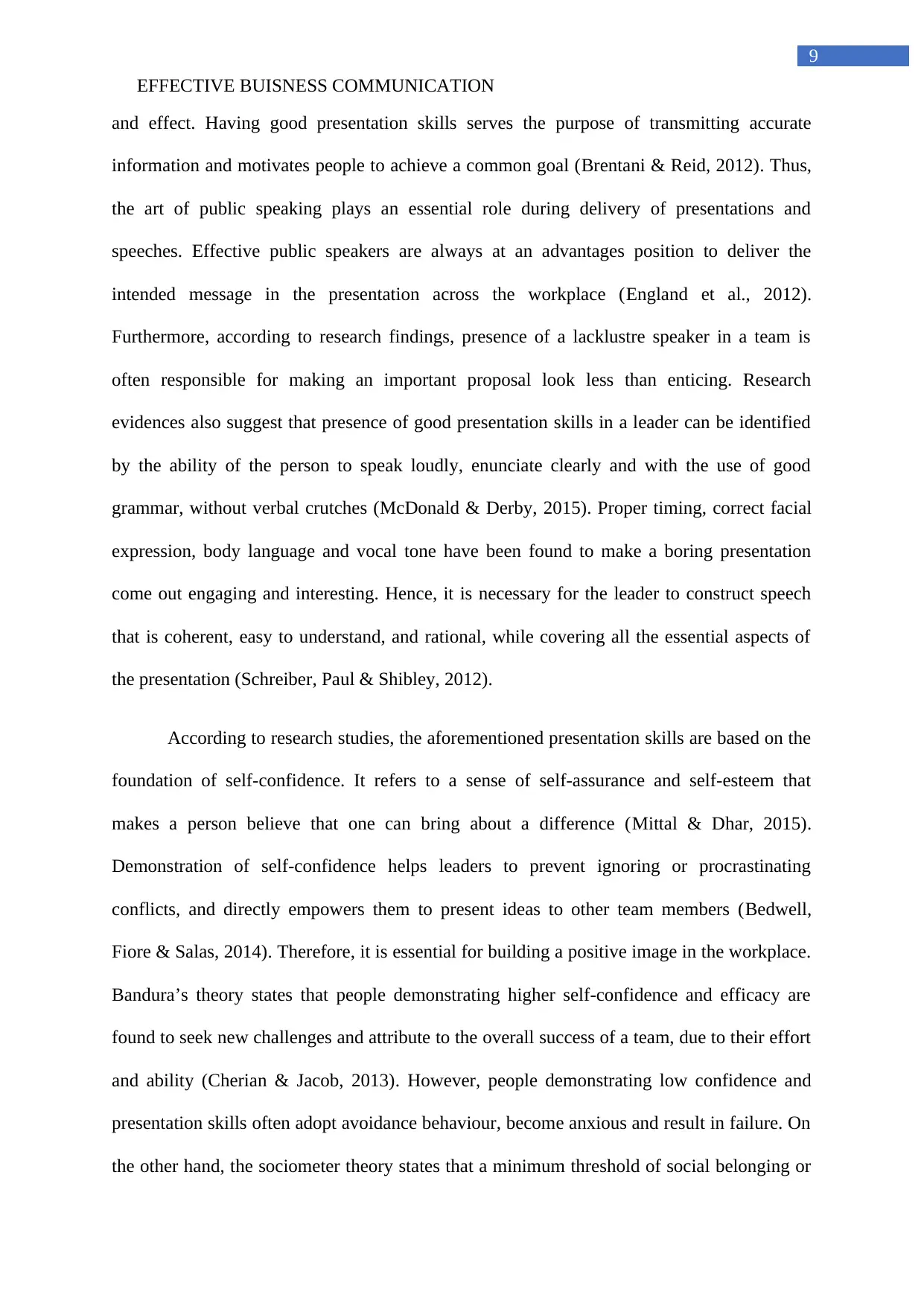
9
EFFECTIVE BUISNESS COMMUNICATION
and effect. Having good presentation skills serves the purpose of transmitting accurate
information and motivates people to achieve a common goal (Brentani & Reid, 2012). Thus,
the art of public speaking plays an essential role during delivery of presentations and
speeches. Effective public speakers are always at an advantages position to deliver the
intended message in the presentation across the workplace (England et al., 2012).
Furthermore, according to research findings, presence of a lacklustre speaker in a team is
often responsible for making an important proposal look less than enticing. Research
evidences also suggest that presence of good presentation skills in a leader can be identified
by the ability of the person to speak loudly, enunciate clearly and with the use of good
grammar, without verbal crutches (McDonald & Derby, 2015). Proper timing, correct facial
expression, body language and vocal tone have been found to make a boring presentation
come out engaging and interesting. Hence, it is necessary for the leader to construct speech
that is coherent, easy to understand, and rational, while covering all the essential aspects of
the presentation (Schreiber, Paul & Shibley, 2012).
According to research studies, the aforementioned presentation skills are based on the
foundation of self-confidence. It refers to a sense of self-assurance and self-esteem that
makes a person believe that one can bring about a difference (Mittal & Dhar, 2015).
Demonstration of self-confidence helps leaders to prevent ignoring or procrastinating
conflicts, and directly empowers them to present ideas to other team members (Bedwell,
Fiore & Salas, 2014). Therefore, it is essential for building a positive image in the workplace.
Bandura’s theory states that people demonstrating higher self-confidence and efficacy are
found to seek new challenges and attribute to the overall success of a team, due to their effort
and ability (Cherian & Jacob, 2013). However, people demonstrating low confidence and
presentation skills often adopt avoidance behaviour, become anxious and result in failure. On
the other hand, the sociometer theory states that a minimum threshold of social belonging or
EFFECTIVE BUISNESS COMMUNICATION
and effect. Having good presentation skills serves the purpose of transmitting accurate
information and motivates people to achieve a common goal (Brentani & Reid, 2012). Thus,
the art of public speaking plays an essential role during delivery of presentations and
speeches. Effective public speakers are always at an advantages position to deliver the
intended message in the presentation across the workplace (England et al., 2012).
Furthermore, according to research findings, presence of a lacklustre speaker in a team is
often responsible for making an important proposal look less than enticing. Research
evidences also suggest that presence of good presentation skills in a leader can be identified
by the ability of the person to speak loudly, enunciate clearly and with the use of good
grammar, without verbal crutches (McDonald & Derby, 2015). Proper timing, correct facial
expression, body language and vocal tone have been found to make a boring presentation
come out engaging and interesting. Hence, it is necessary for the leader to construct speech
that is coherent, easy to understand, and rational, while covering all the essential aspects of
the presentation (Schreiber, Paul & Shibley, 2012).
According to research studies, the aforementioned presentation skills are based on the
foundation of self-confidence. It refers to a sense of self-assurance and self-esteem that
makes a person believe that one can bring about a difference (Mittal & Dhar, 2015).
Demonstration of self-confidence helps leaders to prevent ignoring or procrastinating
conflicts, and directly empowers them to present ideas to other team members (Bedwell,
Fiore & Salas, 2014). Therefore, it is essential for building a positive image in the workplace.
Bandura’s theory states that people demonstrating higher self-confidence and efficacy are
found to seek new challenges and attribute to the overall success of a team, due to their effort
and ability (Cherian & Jacob, 2013). However, people demonstrating low confidence and
presentation skills often adopt avoidance behaviour, become anxious and result in failure. On
the other hand, the sociometer theory states that a minimum threshold of social belonging or
Secure Best Marks with AI Grader
Need help grading? Try our AI Grader for instant feedback on your assignments.
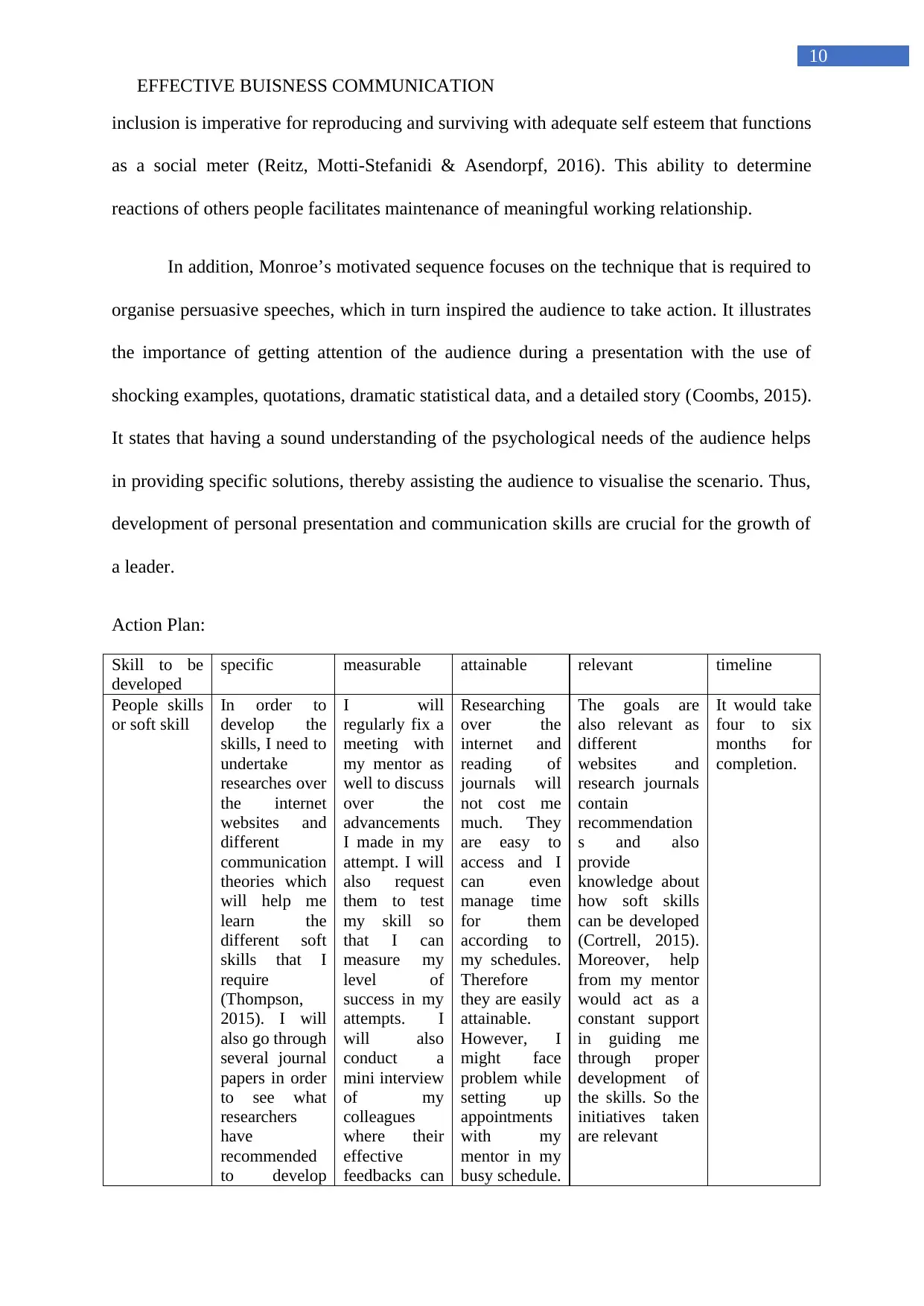
10
EFFECTIVE BUISNESS COMMUNICATION
inclusion is imperative for reproducing and surviving with adequate self esteem that functions
as a social meter (Reitz, Motti-Stefanidi & Asendorpf, 2016). This ability to determine
reactions of others people facilitates maintenance of meaningful working relationship.
In addition, Monroe’s motivated sequence focuses on the technique that is required to
organise persuasive speeches, which in turn inspired the audience to take action. It illustrates
the importance of getting attention of the audience during a presentation with the use of
shocking examples, quotations, dramatic statistical data, and a detailed story (Coombs, 2015).
It states that having a sound understanding of the psychological needs of the audience helps
in providing specific solutions, thereby assisting the audience to visualise the scenario. Thus,
development of personal presentation and communication skills are crucial for the growth of
a leader.
Action Plan:
Skill to be
developed
specific measurable attainable relevant timeline
People skills
or soft skill
In order to
develop the
skills, I need to
undertake
researches over
the internet
websites and
different
communication
theories which
will help me
learn the
different soft
skills that I
require
(Thompson,
2015). I will
also go through
several journal
papers in order
to see what
researchers
have
recommended
to develop
I will
regularly fix a
meeting with
my mentor as
well to discuss
over the
advancements
I made in my
attempt. I will
also request
them to test
my skill so
that I can
measure my
level of
success in my
attempts. I
will also
conduct a
mini interview
of my
colleagues
where their
effective
feedbacks can
Researching
over the
internet and
reading of
journals will
not cost me
much. They
are easy to
access and I
can even
manage time
for them
according to
my schedules.
Therefore
they are easily
attainable.
However, I
might face
problem while
setting up
appointments
with my
mentor in my
busy schedule.
The goals are
also relevant as
different
websites and
research journals
contain
recommendation
s and also
provide
knowledge about
how soft skills
can be developed
(Cortrell, 2015).
Moreover, help
from my mentor
would act as a
constant support
in guiding me
through proper
development of
the skills. So the
initiatives taken
are relevant
It would take
four to six
months for
completion.
EFFECTIVE BUISNESS COMMUNICATION
inclusion is imperative for reproducing and surviving with adequate self esteem that functions
as a social meter (Reitz, Motti-Stefanidi & Asendorpf, 2016). This ability to determine
reactions of others people facilitates maintenance of meaningful working relationship.
In addition, Monroe’s motivated sequence focuses on the technique that is required to
organise persuasive speeches, which in turn inspired the audience to take action. It illustrates
the importance of getting attention of the audience during a presentation with the use of
shocking examples, quotations, dramatic statistical data, and a detailed story (Coombs, 2015).
It states that having a sound understanding of the psychological needs of the audience helps
in providing specific solutions, thereby assisting the audience to visualise the scenario. Thus,
development of personal presentation and communication skills are crucial for the growth of
a leader.
Action Plan:
Skill to be
developed
specific measurable attainable relevant timeline
People skills
or soft skill
In order to
develop the
skills, I need to
undertake
researches over
the internet
websites and
different
communication
theories which
will help me
learn the
different soft
skills that I
require
(Thompson,
2015). I will
also go through
several journal
papers in order
to see what
researchers
have
recommended
to develop
I will
regularly fix a
meeting with
my mentor as
well to discuss
over the
advancements
I made in my
attempt. I will
also request
them to test
my skill so
that I can
measure my
level of
success in my
attempts. I
will also
conduct a
mini interview
of my
colleagues
where their
effective
feedbacks can
Researching
over the
internet and
reading of
journals will
not cost me
much. They
are easy to
access and I
can even
manage time
for them
according to
my schedules.
Therefore
they are easily
attainable.
However, I
might face
problem while
setting up
appointments
with my
mentor in my
busy schedule.
The goals are
also relevant as
different
websites and
research journals
contain
recommendation
s and also
provide
knowledge about
how soft skills
can be developed
(Cortrell, 2015).
Moreover, help
from my mentor
would act as a
constant support
in guiding me
through proper
development of
the skills. So the
initiatives taken
are relevant
It would take
four to six
months for
completion.
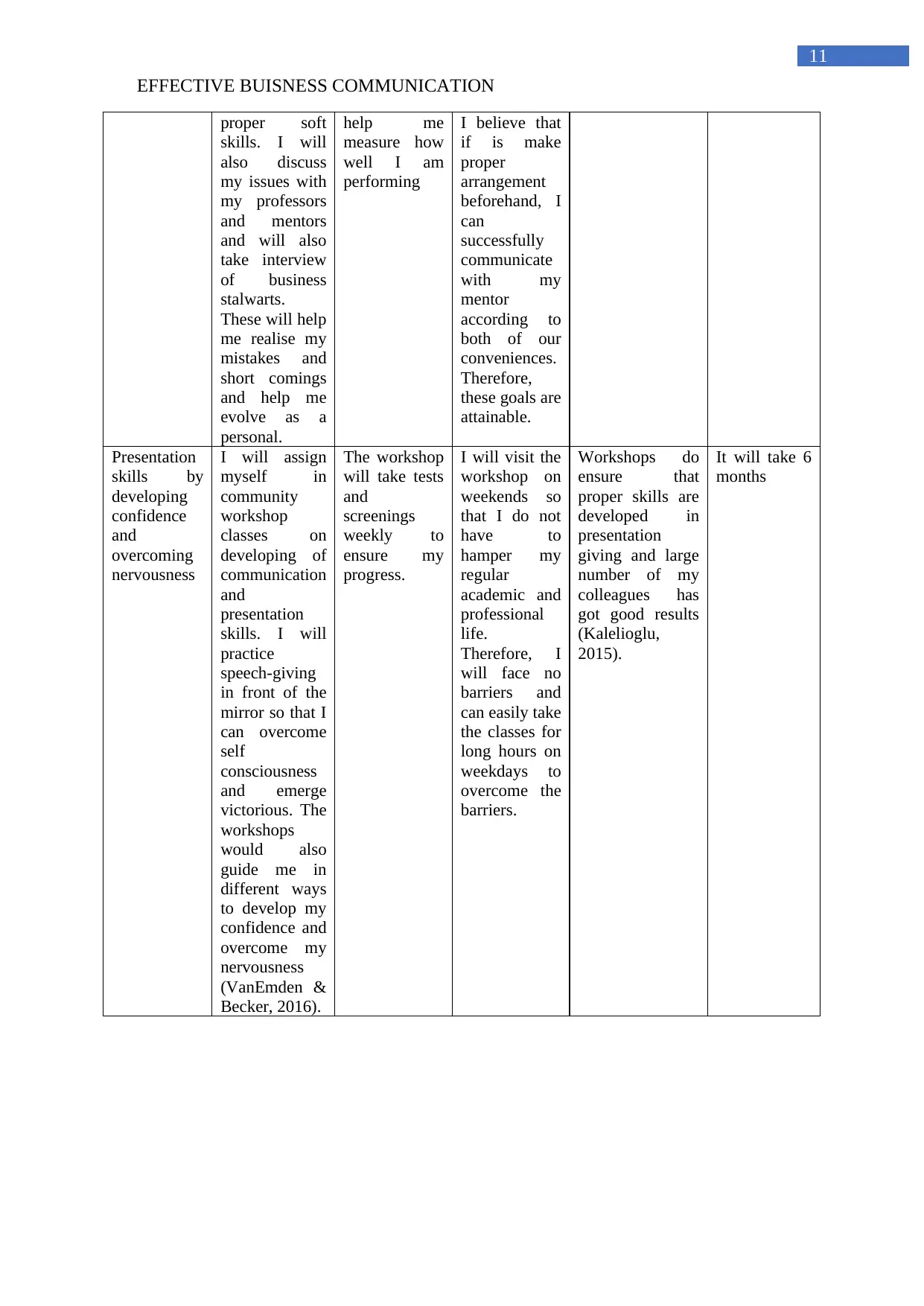
11
EFFECTIVE BUISNESS COMMUNICATION
proper soft
skills. I will
also discuss
my issues with
my professors
and mentors
and will also
take interview
of business
stalwarts.
These will help
me realise my
mistakes and
short comings
and help me
evolve as a
personal.
help me
measure how
well I am
performing
I believe that
if is make
proper
arrangement
beforehand, I
can
successfully
communicate
with my
mentor
according to
both of our
conveniences.
Therefore,
these goals are
attainable.
Presentation
skills by
developing
confidence
and
overcoming
nervousness
I will assign
myself in
community
workshop
classes on
developing of
communication
and
presentation
skills. I will
practice
speech-giving
in front of the
mirror so that I
can overcome
self
consciousness
and emerge
victorious. The
workshops
would also
guide me in
different ways
to develop my
confidence and
overcome my
nervousness
(VanEmden &
Becker, 2016).
The workshop
will take tests
and
screenings
weekly to
ensure my
progress.
I will visit the
workshop on
weekends so
that I do not
have to
hamper my
regular
academic and
professional
life.
Therefore, I
will face no
barriers and
can easily take
the classes for
long hours on
weekdays to
overcome the
barriers.
Workshops do
ensure that
proper skills are
developed in
presentation
giving and large
number of my
colleagues has
got good results
(Kalelioglu,
2015).
It will take 6
months
EFFECTIVE BUISNESS COMMUNICATION
proper soft
skills. I will
also discuss
my issues with
my professors
and mentors
and will also
take interview
of business
stalwarts.
These will help
me realise my
mistakes and
short comings
and help me
evolve as a
personal.
help me
measure how
well I am
performing
I believe that
if is make
proper
arrangement
beforehand, I
can
successfully
communicate
with my
mentor
according to
both of our
conveniences.
Therefore,
these goals are
attainable.
Presentation
skills by
developing
confidence
and
overcoming
nervousness
I will assign
myself in
community
workshop
classes on
developing of
communication
and
presentation
skills. I will
practice
speech-giving
in front of the
mirror so that I
can overcome
self
consciousness
and emerge
victorious. The
workshops
would also
guide me in
different ways
to develop my
confidence and
overcome my
nervousness
(VanEmden &
Becker, 2016).
The workshop
will take tests
and
screenings
weekly to
ensure my
progress.
I will visit the
workshop on
weekends so
that I do not
have to
hamper my
regular
academic and
professional
life.
Therefore, I
will face no
barriers and
can easily take
the classes for
long hours on
weekdays to
overcome the
barriers.
Workshops do
ensure that
proper skills are
developed in
presentation
giving and large
number of my
colleagues has
got good results
(Kalelioglu,
2015).
It will take 6
months
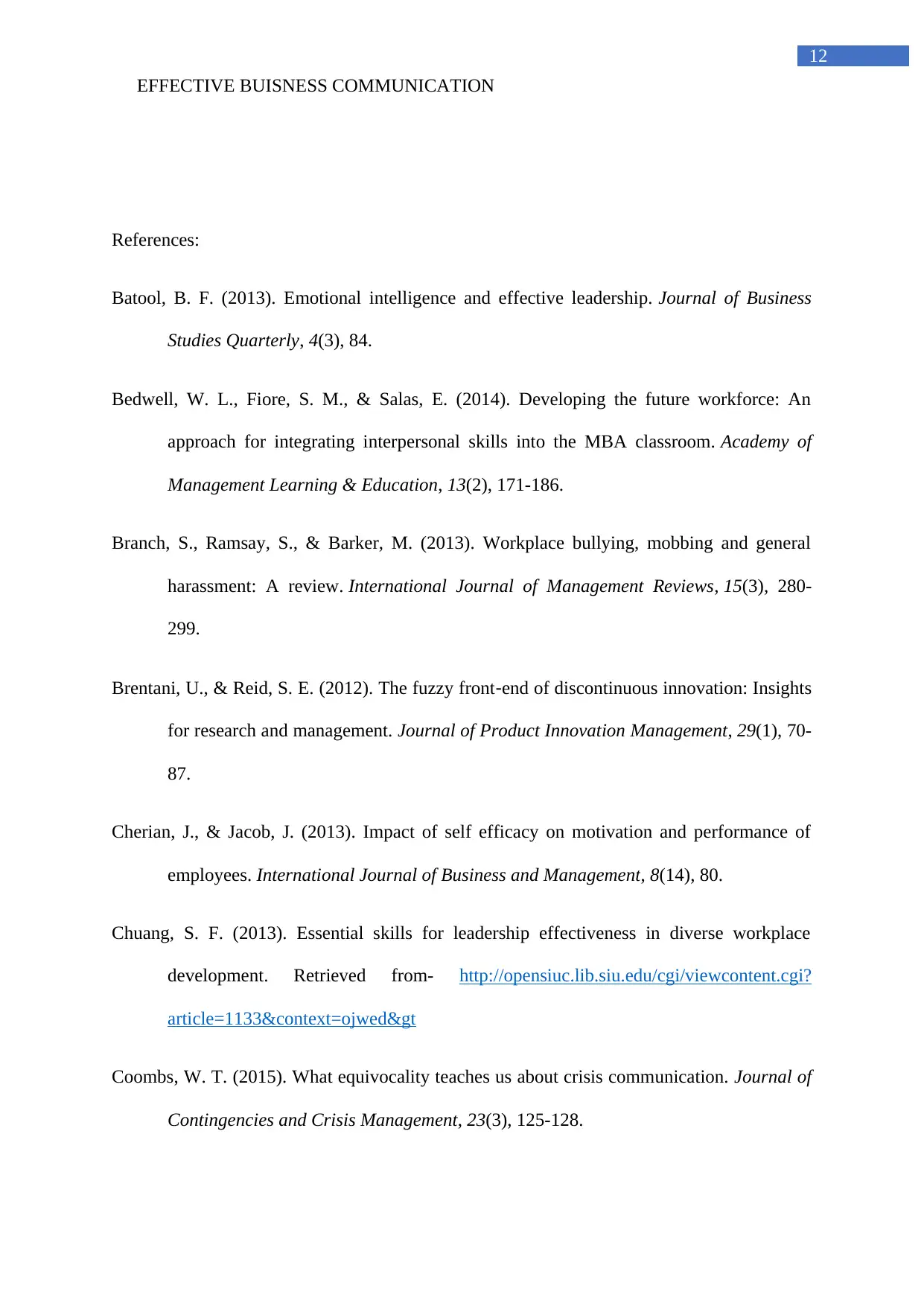
12
EFFECTIVE BUISNESS COMMUNICATION
References:
Batool, B. F. (2013). Emotional intelligence and effective leadership. Journal of Business
Studies Quarterly, 4(3), 84.
Bedwell, W. L., Fiore, S. M., & Salas, E. (2014). Developing the future workforce: An
approach for integrating interpersonal skills into the MBA classroom. Academy of
Management Learning & Education, 13(2), 171-186.
Branch, S., Ramsay, S., & Barker, M. (2013). Workplace bullying, mobbing and general
harassment: A review. International Journal of Management Reviews, 15(3), 280-
299.
Brentani, U., & Reid, S. E. (2012). The fuzzy front‐end of discontinuous innovation: Insights
for research and management. Journal of Product Innovation Management, 29(1), 70-
87.
Cherian, J., & Jacob, J. (2013). Impact of self efficacy on motivation and performance of
employees. International Journal of Business and Management, 8(14), 80.
Chuang, S. F. (2013). Essential skills for leadership effectiveness in diverse workplace
development. Retrieved from- http://opensiuc.lib.siu.edu/cgi/viewcontent.cgi?
article=1133&context=ojwed>
Coombs, W. T. (2015). What equivocality teaches us about crisis communication. Journal of
Contingencies and Crisis Management, 23(3), 125-128.
EFFECTIVE BUISNESS COMMUNICATION
References:
Batool, B. F. (2013). Emotional intelligence and effective leadership. Journal of Business
Studies Quarterly, 4(3), 84.
Bedwell, W. L., Fiore, S. M., & Salas, E. (2014). Developing the future workforce: An
approach for integrating interpersonal skills into the MBA classroom. Academy of
Management Learning & Education, 13(2), 171-186.
Branch, S., Ramsay, S., & Barker, M. (2013). Workplace bullying, mobbing and general
harassment: A review. International Journal of Management Reviews, 15(3), 280-
299.
Brentani, U., & Reid, S. E. (2012). The fuzzy front‐end of discontinuous innovation: Insights
for research and management. Journal of Product Innovation Management, 29(1), 70-
87.
Cherian, J., & Jacob, J. (2013). Impact of self efficacy on motivation and performance of
employees. International Journal of Business and Management, 8(14), 80.
Chuang, S. F. (2013). Essential skills for leadership effectiveness in diverse workplace
development. Retrieved from- http://opensiuc.lib.siu.edu/cgi/viewcontent.cgi?
article=1133&context=ojwed>
Coombs, W. T. (2015). What equivocality teaches us about crisis communication. Journal of
Contingencies and Crisis Management, 23(3), 125-128.
Paraphrase This Document
Need a fresh take? Get an instant paraphrase of this document with our AI Paraphraser
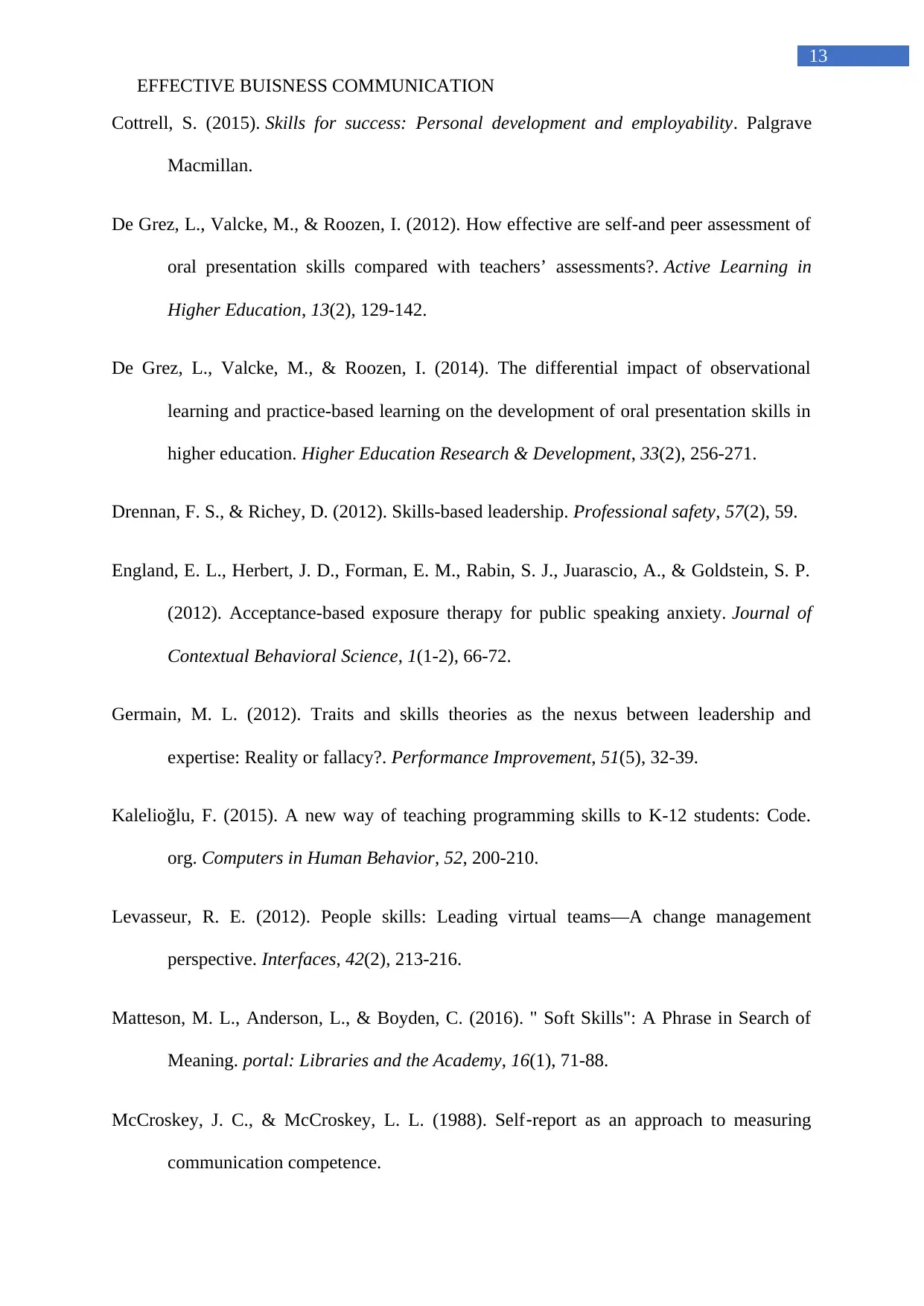
13
EFFECTIVE BUISNESS COMMUNICATION
Cottrell, S. (2015). Skills for success: Personal development and employability. Palgrave
Macmillan.
De Grez, L., Valcke, M., & Roozen, I. (2012). How effective are self-and peer assessment of
oral presentation skills compared with teachers’ assessments?. Active Learning in
Higher Education, 13(2), 129-142.
De Grez, L., Valcke, M., & Roozen, I. (2014). The differential impact of observational
learning and practice-based learning on the development of oral presentation skills in
higher education. Higher Education Research & Development, 33(2), 256-271.
Drennan, F. S., & Richey, D. (2012). Skills-based leadership. Professional safety, 57(2), 59.
England, E. L., Herbert, J. D., Forman, E. M., Rabin, S. J., Juarascio, A., & Goldstein, S. P.
(2012). Acceptance-based exposure therapy for public speaking anxiety. Journal of
Contextual Behavioral Science, 1(1-2), 66-72.
Germain, M. L. (2012). Traits and skills theories as the nexus between leadership and
expertise: Reality or fallacy?. Performance Improvement, 51(5), 32-39.
Kalelioğlu, F. (2015). A new way of teaching programming skills to K-12 students: Code.
org. Computers in Human Behavior, 52, 200-210.
Levasseur, R. E. (2012). People skills: Leading virtual teams—A change management
perspective. Interfaces, 42(2), 213-216.
Matteson, M. L., Anderson, L., & Boyden, C. (2016). " Soft Skills": A Phrase in Search of
Meaning. portal: Libraries and the Academy, 16(1), 71-88.
McCroskey, J. C., & McCroskey, L. L. (1988). Self‐report as an approach to measuring
communication competence.
EFFECTIVE BUISNESS COMMUNICATION
Cottrell, S. (2015). Skills for success: Personal development and employability. Palgrave
Macmillan.
De Grez, L., Valcke, M., & Roozen, I. (2012). How effective are self-and peer assessment of
oral presentation skills compared with teachers’ assessments?. Active Learning in
Higher Education, 13(2), 129-142.
De Grez, L., Valcke, M., & Roozen, I. (2014). The differential impact of observational
learning and practice-based learning on the development of oral presentation skills in
higher education. Higher Education Research & Development, 33(2), 256-271.
Drennan, F. S., & Richey, D. (2012). Skills-based leadership. Professional safety, 57(2), 59.
England, E. L., Herbert, J. D., Forman, E. M., Rabin, S. J., Juarascio, A., & Goldstein, S. P.
(2012). Acceptance-based exposure therapy for public speaking anxiety. Journal of
Contextual Behavioral Science, 1(1-2), 66-72.
Germain, M. L. (2012). Traits and skills theories as the nexus between leadership and
expertise: Reality or fallacy?. Performance Improvement, 51(5), 32-39.
Kalelioğlu, F. (2015). A new way of teaching programming skills to K-12 students: Code.
org. Computers in Human Behavior, 52, 200-210.
Levasseur, R. E. (2012). People skills: Leading virtual teams—A change management
perspective. Interfaces, 42(2), 213-216.
Matteson, M. L., Anderson, L., & Boyden, C. (2016). " Soft Skills": A Phrase in Search of
Meaning. portal: Libraries and the Academy, 16(1), 71-88.
McCroskey, J. C., & McCroskey, L. L. (1988). Self‐report as an approach to measuring
communication competence.
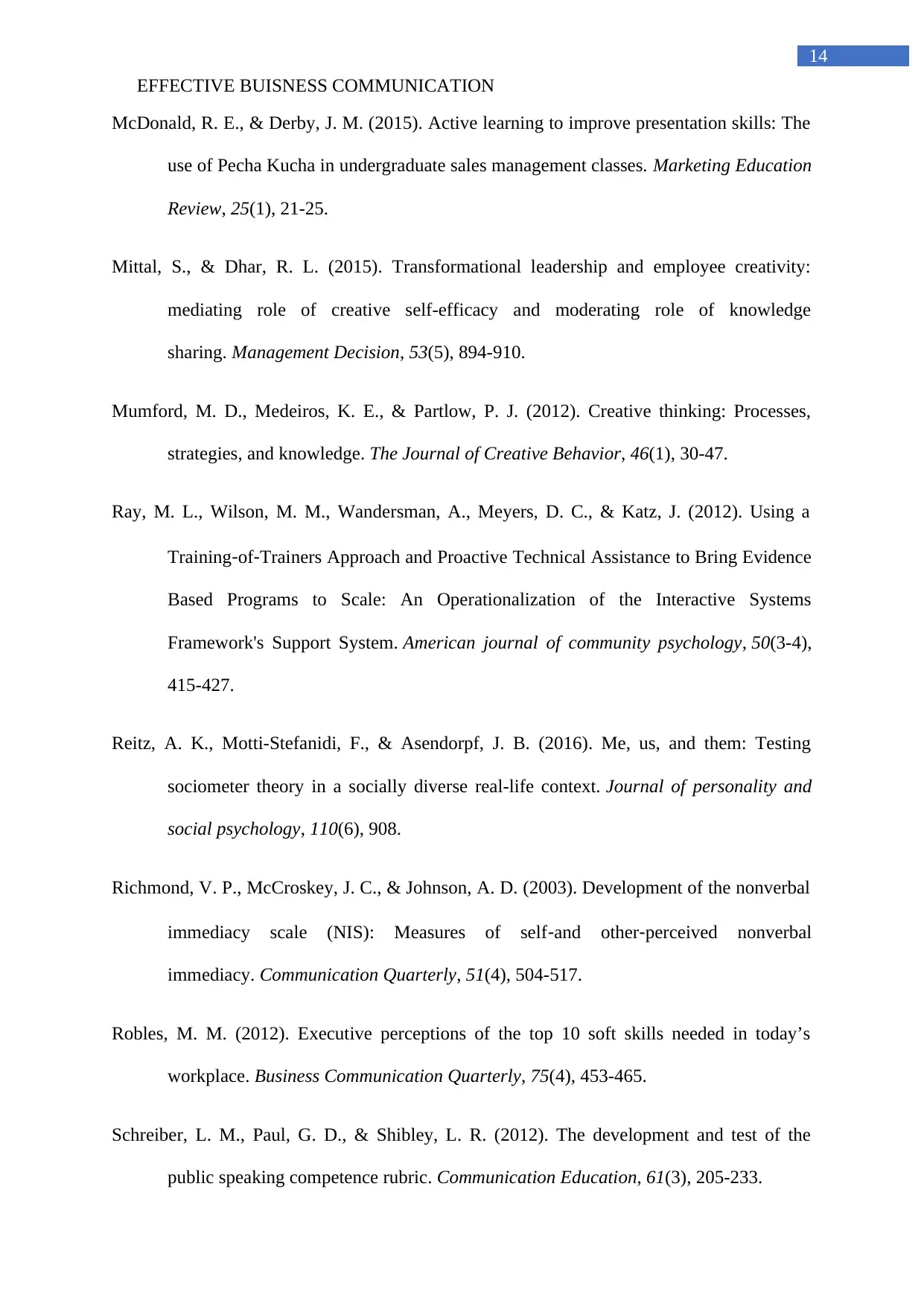
14
EFFECTIVE BUISNESS COMMUNICATION
McDonald, R. E., & Derby, J. M. (2015). Active learning to improve presentation skills: The
use of Pecha Kucha in undergraduate sales management classes. Marketing Education
Review, 25(1), 21-25.
Mittal, S., & Dhar, R. L. (2015). Transformational leadership and employee creativity:
mediating role of creative self-efficacy and moderating role of knowledge
sharing. Management Decision, 53(5), 894-910.
Mumford, M. D., Medeiros, K. E., & Partlow, P. J. (2012). Creative thinking: Processes,
strategies, and knowledge. The Journal of Creative Behavior, 46(1), 30-47.
Ray, M. L., Wilson, M. M., Wandersman, A., Meyers, D. C., & Katz, J. (2012). Using a
Training‐of‐Trainers Approach and Proactive Technical Assistance to Bring Evidence
Based Programs to Scale: An Operationalization of the Interactive Systems
Framework's Support System. American journal of community psychology, 50(3-4),
415-427.
Reitz, A. K., Motti-Stefanidi, F., & Asendorpf, J. B. (2016). Me, us, and them: Testing
sociometer theory in a socially diverse real-life context. Journal of personality and
social psychology, 110(6), 908.
Richmond, V. P., McCroskey, J. C., & Johnson, A. D. (2003). Development of the nonverbal
immediacy scale (NIS): Measures of self‐and other‐perceived nonverbal
immediacy. Communication Quarterly, 51(4), 504-517.
Robles, M. M. (2012). Executive perceptions of the top 10 soft skills needed in today’s
workplace. Business Communication Quarterly, 75(4), 453-465.
Schreiber, L. M., Paul, G. D., & Shibley, L. R. (2012). The development and test of the
public speaking competence rubric. Communication Education, 61(3), 205-233.
EFFECTIVE BUISNESS COMMUNICATION
McDonald, R. E., & Derby, J. M. (2015). Active learning to improve presentation skills: The
use of Pecha Kucha in undergraduate sales management classes. Marketing Education
Review, 25(1), 21-25.
Mittal, S., & Dhar, R. L. (2015). Transformational leadership and employee creativity:
mediating role of creative self-efficacy and moderating role of knowledge
sharing. Management Decision, 53(5), 894-910.
Mumford, M. D., Medeiros, K. E., & Partlow, P. J. (2012). Creative thinking: Processes,
strategies, and knowledge. The Journal of Creative Behavior, 46(1), 30-47.
Ray, M. L., Wilson, M. M., Wandersman, A., Meyers, D. C., & Katz, J. (2012). Using a
Training‐of‐Trainers Approach and Proactive Technical Assistance to Bring Evidence
Based Programs to Scale: An Operationalization of the Interactive Systems
Framework's Support System. American journal of community psychology, 50(3-4),
415-427.
Reitz, A. K., Motti-Stefanidi, F., & Asendorpf, J. B. (2016). Me, us, and them: Testing
sociometer theory in a socially diverse real-life context. Journal of personality and
social psychology, 110(6), 908.
Richmond, V. P., McCroskey, J. C., & Johnson, A. D. (2003). Development of the nonverbal
immediacy scale (NIS): Measures of self‐and other‐perceived nonverbal
immediacy. Communication Quarterly, 51(4), 504-517.
Robles, M. M. (2012). Executive perceptions of the top 10 soft skills needed in today’s
workplace. Business Communication Quarterly, 75(4), 453-465.
Schreiber, L. M., Paul, G. D., & Shibley, L. R. (2012). The development and test of the
public speaking competence rubric. Communication Education, 61(3), 205-233.
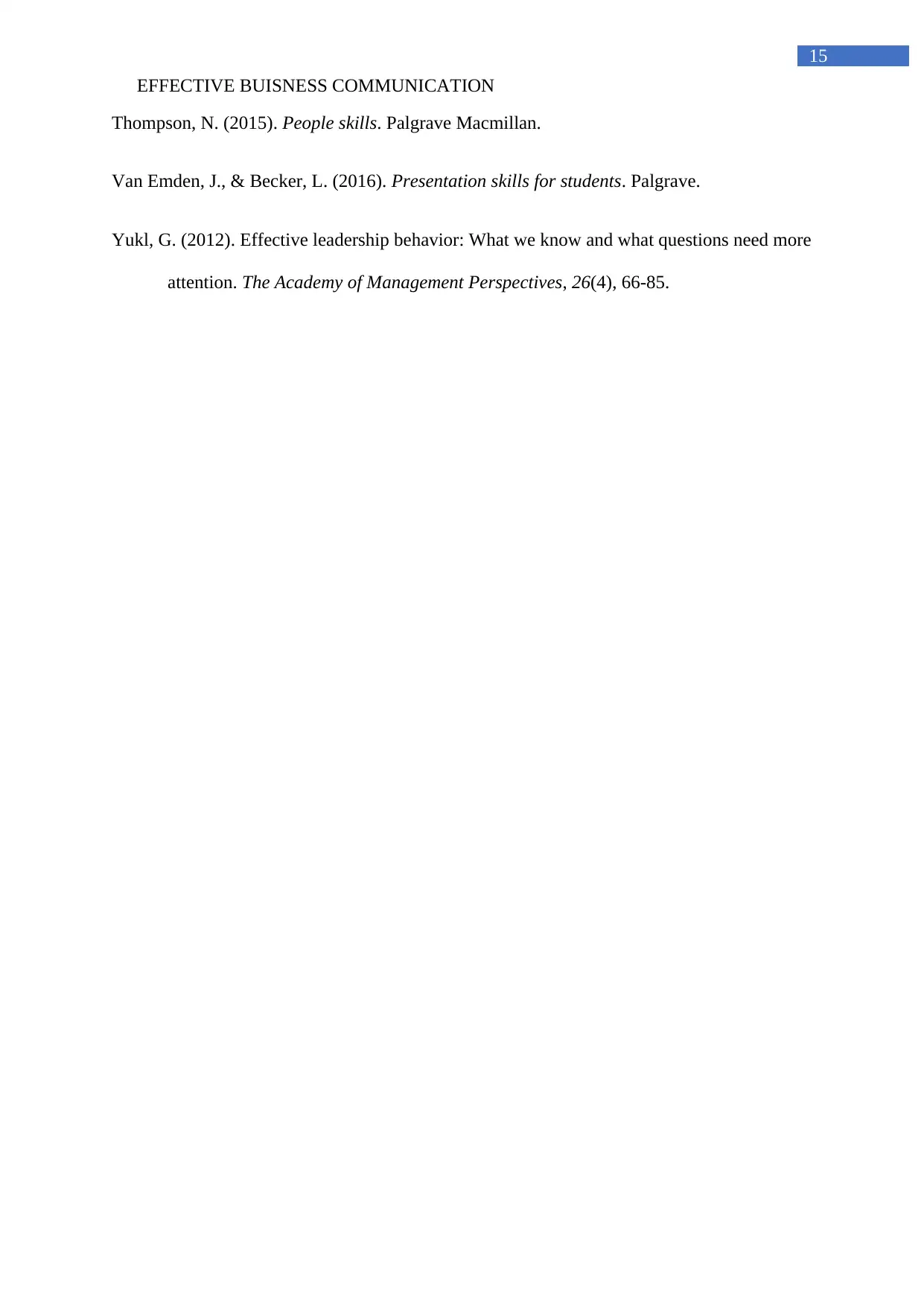
15
EFFECTIVE BUISNESS COMMUNICATION
Thompson, N. (2015). People skills. Palgrave Macmillan.
Van Emden, J., & Becker, L. (2016). Presentation skills for students. Palgrave.
Yukl, G. (2012). Effective leadership behavior: What we know and what questions need more
attention. The Academy of Management Perspectives, 26(4), 66-85.
EFFECTIVE BUISNESS COMMUNICATION
Thompson, N. (2015). People skills. Palgrave Macmillan.
Van Emden, J., & Becker, L. (2016). Presentation skills for students. Palgrave.
Yukl, G. (2012). Effective leadership behavior: What we know and what questions need more
attention. The Academy of Management Perspectives, 26(4), 66-85.
1 out of 16
Related Documents
Your All-in-One AI-Powered Toolkit for Academic Success.
+13062052269
info@desklib.com
Available 24*7 on WhatsApp / Email
![[object Object]](/_next/static/media/star-bottom.7253800d.svg)
Unlock your academic potential
© 2024 | Zucol Services PVT LTD | All rights reserved.



